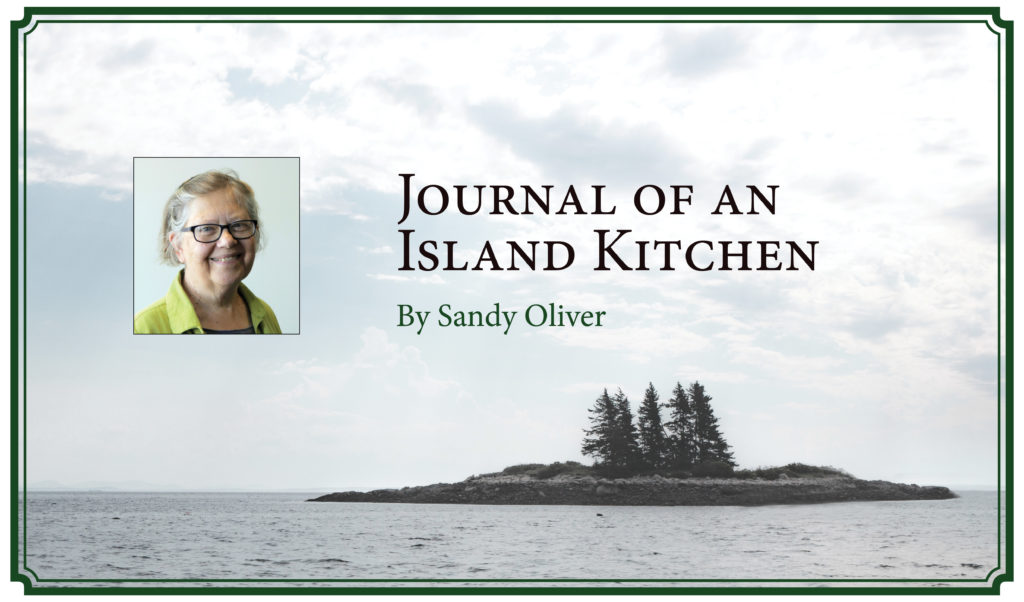By Sandy Oliver
If you are as old as I am, you can remember life without pizza. I was about 14 before I had my first piece of pizza in New Preston, Conn., at a tiny pizzeria near the shore of Lake Waramaug: plain cheese pizza sprinkled with oregano transported our family into pretty exotic territory.
Mom asked the waiter about the herb they used, which is how I know it was oregano. Thereafter she sprinkled it onto every hamburger she cooked, which I suppose set new standards for sophisticated cookery at our house. Still, we didn’t have pizza that often and it would be another five to six years when I went to college before pizza joined the list of familiar and favorite fare.
Any New England family whose elders had a vivid memory of the Depression and World War II rationing, and who lived plainly and frugally, would be astonished as the last quarter of the 20th century and early 21st rolled out affordable artichokes, avocadoes, any lettuce that wasn’t iceberg, abundant boneless chicken breasts, kiwis, never mind sushi, Thai cookery, kimchi, and kombucha.
Even good coffee. My parents, grandparents, and older relatives all always drank instant coffee. When I was little, our next door neighbors, who had a television when my family did not, invited us over to watch with them (wrestling, I remember and I’ve Got a Secret) and Aunt Susie always made percolator coffee in a Pyrex pot. I recall the bubbling water riding up the glass tube and dark streams of coffee filtering down into the hot water in the blue light of a gas flame, but I was too young to drink it.
When I went to housekeeping as a 21-year-old, I perked coffee in an aluminum pot. It was better than instant but the first truly delicious coffee I ever drank was in 1973 at a Montreal crepe restaurant—first crepe, too—that I visited with friends I made on the trans-Canadian railroad during my return trip from an adventure to the West Coast, where I had my first taste of espresso—wow—at an outdoor café in San Francisco’s Ghiardelli Square. These days, many wonderful artisanal coffee roasters, and, no matter what else you might think of them, Starbucks, have averaged up the quality of coffee generally.
The 1970s marked a lot of gustatory firsts for me, partly because I left my childhood home and was done with college cafeteria food. I discovered that I really like mashed potatoes when they weren’t boxed instant; that non-instant oatmeal was chewy and delicious; that fresh flounder broiled with dots of butter was wonderful and fish sticks became a thing of the past. Historic cooking uncovered a world of wonderful cake made with butter, sugar, flour, and eggs; I, raised on box mixes, didn’t know that I liked cake until I had a good one from an early 1800s recipe.
Then there were the new things I met with, like hummus made by some friends in a commune in Somerville, Mass., brown rice, and tabbouleh. Or like the quiche my friend Jane Hutchins baked long before anyone ever told me that real men didn’t eat it.
Jane, who had spent a college year abroad in Belgium, also introduced me to mussels and shandy. She ate a lot of mussels in Belgium so when I visited her at her family’s summer cottage in Little Compton, R.I., we two waded along the Sakonnet Point shore, picking mussels off rockweed-covered rocks, dropping them into the canvas bag we carried between us. I learned to remove the beard and steam them with onions and wine, then eat them using one pair of still-hinged shells as tongs to pluck the rest from their shells, and dip them into melted butter. Heaven. And beer and lemonade mixed to wash it down.
Oh, my gosh, delicious.
We gathered rosehips from rosa rugosaon that trip, too, and made delicious rosehip marmalade, an experience rendered miserable with the hips’ prickly, itchy, seed-ridden insides which had to be removed before cooking them with sugar, julienned rinds of orange and lemon, and chopped crystalized ginger.
Still, it was all a life changing experience because I swore that henceforth I wanted to live somewhere that I could live off the land by foraging from the natural abundance and growing a big garden.
An island in Penobscot Bay proved to be the very place.
Sandy Oliver is a food historian who lives, gardens, cooks, and writes on Islesboro.





